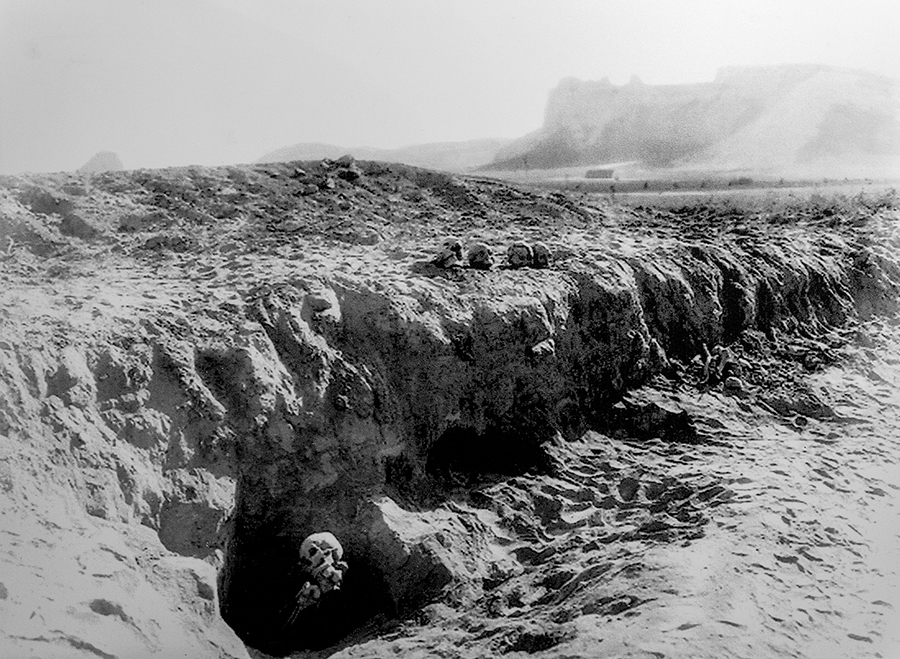| NEBRASKA |
On August 24th, 1932, potato farmer Henry Bisterfeldt of Gering, Nebraska, hired several workmen to excavate a new potato storage cellar on the northwest side of his property near the face of a 10-foot-high escarpment a quarter-mile northeast of Scotts Bluff National Monument. What followed became the talk of the twin-city area for weeks afterward as an important archeological site was accidentally discovered containing the skeletons of 32 adults and five infants of presumed Woodland Plains Indian hunter-gatherers in four separate pits.
By: Hawk Buckman
Published May 11, 2022
The study of human burials provides us with a rich source of information about people’s lives-who they were, what activities they pursued during life, and how they may have participated in rituals of death and mourning. Bio-archaeologists consider skeletal biology and mortuary offerings context to make interpretations about the past.
Archaeologists and physical anthropologists have studied human burial sites from the Northwestern Plains since the inception of professional archaeology in the region during the 1930s. Most mortuary sites include one or two individuals found in isolated, often threatened, graves. The majority have been excavated under salvage conditions to preserve the materials from destruction related to road and reservoir construction, mineral development, and erosion.
The Bisterfeldt potato seller site falls under these conditions, and like most Woodland Plains Indian hunter-gatherers’ mortuary sites discovered from the 1930s through the present have subsequently been turned into paved roads and housing developments.
Humans have been in the central High Plains region for about 12,000 years. Archeologists define the cultural eras for this region in slightly different ways, but the salient phases are Paleoindian (12,000-9,000 BP before the present), Plains Archaic (9,000r,000 BP), Plains Woodland (1-i000), Plains Village (1000-1500), and Historic (since 15oo).
Megafaunas such as mammoths and bison drew Paleoindian peoples to the High Plains. They practiced mixed hunting and gathering subsistence strategy, a major component of which was the pursuit of big game. The Scottsbluff Bison Quarry near Signal Butte reflects hunting activity in this period. The site is a large 9,000- to 10,000-year-old deposit of bison bones from a now-extinct species (Bison antiquus), along with some darl points, flakes, and charcoal fragments.
The Scottsbluff projectile point type, named for this site, was used across the Plains from Texas to Canada and also has also been found in the Great Lakes region.
A shift to warmer, drier conditions altered the grasslands and caused the megafauna to disappear. Humanity’s subsistence strategies in western Nebraska changed accordingly, creating the Plains Archaic pattern. Between 9,000 and 2,000 years ago, Plains Archaic peoples were nomadic and relied on many plants and animals, a more diverse set of resources than during the Paleoindian period. Sites in the region, such as Signal Butte and the Bisterfeldt Potato Cellar (Gering) provide evidence of the Plains Archaic cultural pattern.
Climate change continued; a wetter and cooler phase began about 2,000 years ago. At the same time, Woodland cultural patterns became more evident in western Nebraska, signified by the use of pottery. The plains Woodland peoples practiced a mixed horticultural and hunting subsistence strategy.
“A sizeable ossuary, almost certainly Woodland, was found in 1932 at Scottsbluff in the extreme western part of the Nebraska panhandle. While digging a potato cellar on the Henry Bisterfeldt property, workmen encountered human bones, some of which were salvaged by interested amateurs. In 1941 information from this excavation was recorded by personnel of the Scottsbluff National Monument, and a resulting manuscript (Mattes 1965) was eventually published, along with comments by Breternitz and Wood (1965). ” – James H. Gunnerson
| DIGGING UP THE PAST
Unfortunately. history doesn’t record the events that occurred after the immediate discovery of the ossuary site. There’s no evidence of who contacted who and what happened after the fact. What is recorded is that Al Moore (Scottsbluff, NE) took control of the excavation and began hastily documenting the site as best he could while attempting to keep amateurs and spectators from pilfering the artifacts at the site as the news of the find had reached far and wide in Scotts Bluff County drawing people from as far away as Torrington, Wyoming to the site.
We know that Moore was given permission to excavate the site for three days and did his best to document and collect as much as he could of the archeological material as work on the cellar continued. Little could be done to prevent onlookers from removing items. The excavation revealed that the site, situated on a ridge, contained the skeletons of 32 adults and 2 infants located in four pits.
It’s assumed that Moore contacted David Breternitz of the Colorado Archaeological Society and John Wood, who took an interest in the find and eventually arrived at the site from Denver to assist Moore. Breternitz classified the site as Woodland and connected it to other Woodland burials on the High Plains.
A total of four burial pits and human remains, some that appeared to be charred, were found buried inside the wall escarpment. One infant burial was in a pit with over 700 tubular bone beads from 12 to 24 mm long. One of the flexed adult skeletons was buried with a shell pendant and was found in a pit with 19 other individuals, presumably secondary burials.
Recovered from the site were a scraper, projectile points, shell pendants, a bone awl, and possible atlatl weights.
Information about the site is frequently referenced when discussing Plains Indians, but little published research exists. However, evidence suggests that the site provides evidence for the westward extension of prehistoric mound cultures, evidenced by the ornamentation of the bodies and the material found in the cells.
The site would be located just northeast of Monument Shadows Golf Course in Gering, NE. The location is now a housing subdivision.
The story of a prehistoric man in western Nebraska is still incomplete. Only a dim outline of the ancient past is beginning to emerge from the patient studies of archeologists.
| REFERENCES
The information in this article has been compiled from the following:
- Life and Death on the Northwestern Plains: Mortuary Practices and Cultural Transformations by Laural Scheibe
- Legacy of the Plains Museum, Gering, NE | E. S. Wood collection of Indian projectile points and other artifacts, found in Scotts Bluff County, Nebraska.
- Gretchen Deter – North Platte Valley Museum
- J. Mattes, “Archaeology of the Bisterfeldt Potato Cellar Site,” Southwestern Lore. (December 1965).
- David A. Bretemitz and John J. Wood, “Comments on the Bisterfeldt Potato Cellar Site and Flexed Burials in the Western Plains,” Southwestern Lore 37, no. 3 (December 1965).
- Amy Koch, High Plains Archeology, Explore Nebraska Archeology No.-5 ([Lincoln]: Nebraska State Historical Society, 2010).
- Archaeology Of The High Plains – James H. Gunnerson
- Salt Lake Tribune Newspaper Archives – August 26, 1932







